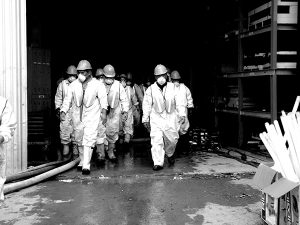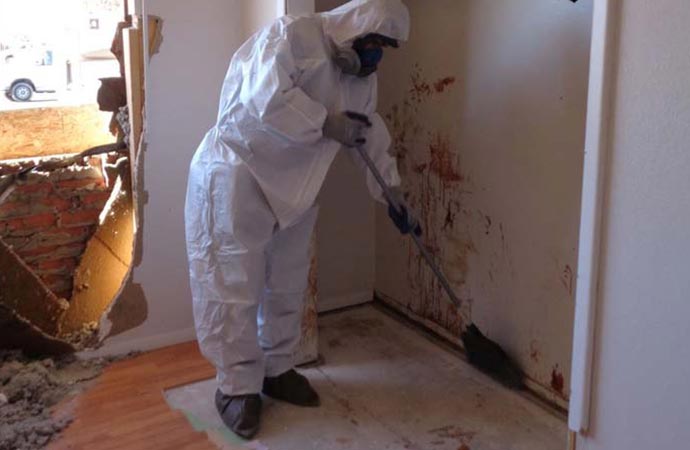Mold Remediation Solutions: Safeguarding Your Residential Property from Mold And Mildew Damage
Mold Remediation Solutions: Safeguarding Your Residential Property from Mold And Mildew Damage
Blog Article
Specialist Biohazard Cleansing and Decontamination for Blood, Bodily Fluids, and Hazardous Materials
The prospective wellness threats connected with exposure to biohazards highlight the vital need for meticulous handling and thorough cleaning. As we browse the elaborate landscape of biohazard clean-up, comprehending the subtleties of guidelines, conformity, and the specialized equipment at play becomes critical in guaranteeing a detailed and safe decontamination procedure.
Wellness Risks of Biohazard Direct Exposure
Exposure to biohazards positions significant health threats that can result in extreme consequences for people and neighborhoods alike. Biohazards encompass a vast array of biological materials, including blood, bodily fluids, mold, microorganisms, viruses, and various other potentially contagious materials. When individuals enter contact with these biohazards, whether through crashes, improper handling, or environmental exposure, they deal with the danger of contracting severe ailments or illness.
Among the primary wellness dangers connected with biohazard exposure is the transmission of infectious diseases. Bloodborne virus such as HIV, liver disease B and C, and numerous microorganisms can be present in biohazardous products, posing a direct risk to human health and wellness. Inhaling airborne biohazards like mold spores or entering into contact with contaminated surface areas can also lead to respiratory issues, allergies, and various other unfavorable health impacts.
In addition, biohazard direct exposure can have long-term wellness ramifications, with some diseases materializing years after the initial call (Blood Cleanup). Consequently, it is crucial to prioritize proper biohazard cleaning and purification to alleviate these health dangers and make sure the safety and security of communities and individuals

Specialized Educating for Biohazard Cleaning
When it comes to taking care of biohazard cleaning effectively and securely, specialized training plays an essential role in guaranteeing correct purification procedures are adhered to. Biohazard clean-up requires certain understanding and abilities to efficiently reduce threats connected with bloodborne virus, bodily liquids, and unsafe materials. Professionals educated in biohazard cleanup go through extensive direction on just how to securely manage, remove, and take care of biohazardous products to avoid contamination and direct exposure.
Specialized training for biohazard cleanup covers a series of crucial subjects, including correct personal safety equipment (PPE) use, bloodborne microorganism recognition, purification strategies, and contaminated materials disposal protocols. People learnt biohazard clean-up are furnished with the required knowledge to analyze contamination levels, recognize possible dangers, and apply proper cleaning procedures in conformity with regulatory requirements.
Constant training and education and learning are critical in the area of biohazard cleaning to stay updated on the most current decontamination technologies, safety methods, and guidelines. By investing in specialized training, biohazard cleaning experts can efficiently react to emergency situation cleanup circumstances and protect both public wellness and the atmosphere.
Importance of Appropriate Decontamination Methods
Utilizing appropriate purification strategies is critical in biohazard cleaning to properly lessen and remove hazardous products wellness threats. Reliable purification not just ensures the removal of visible traces of blood, bodily liquids, and various other biohazards these details but additionally targets unnoticeable virus that might position significant health and wellness dangers otherwise properly gotten rid of. By adhering to rigid decontamination procedures, trained specialists can significantly lower the threat of direct exposure to harmful microbes, infections, and bacteria that might bring about illness or infections.
Appropriate decontamination methods involve using specialized tools and anti-bacterials that are especially designed to counteract biohazards effectively. Extensive cleaning and sanitation of polluted locations are important to stop the spread of microorganisms and make sure a safe atmosphere for passengers. Additionally, the appropriate disposal of biohazardous waste adhering to decontamination treatments is important in preventing contamination of other surfaces or people.

Devices and Tools for Safe Clean-up
When dealing with blood, bodily fluids, or hazardous materials, biohazard cleansing experts rely on specialized gear to minimize direct exposure dangers and extensively decontaminate the afflicted area. Furthermore, biohazard cleaning sets having anti-bacterials, absorptive materials, and biohazard bags are made use of to securely include and get rid of of polluted things.
Advanced cleansing devices like hospital-grade disinfectants, HEPA-filtered vacuums, and fogging equipments are utilized to disinfect surface areas and get rid of biohazards successfully. Specialized equipment such as sharps containers and biohazard garbage disposal containers are utilized to safely manage sharp items and biohazardous waste products. By using the appropriate equipment and devices, biohazard cleansing specialists can ensure a thorough clean-up blood clean up solution process that focuses on safety and reduces wellness threats for both employees and passengers of the affected space.
Rules and Compliance in Biohazard Cleaning
Correct adherence to regulations and conformity requirements is critical in biohazard cleansing to ensure the security of both employees and the environment. Federal government firms such as OSHA (Occupational Security and Health Administration) and the EPA (Epa) have actually established particular guidelines for biohazard cleaning treatments to decrease health threats and ecological contamination. These regulations cover a variety of facets consisting of the handling, transport, and disposal of biohazardous materials, in addition to the necessary training and protective equipment required for personnel associated with the cleaning process.
Biohazard cleansing firms need to stay up-to-date with these guidelines to assure that their operations fulfill the required safety and security criteria. Failure to adhere to these policies can cause extreme repercussions, including penalties, lawful activity, and endangering the wellness of individuals and the environment. By complying with stringent policies and conformity procedures, biohazard cleansing firms can properly mitigate risks and guarantee a safe and thorough cleaning process for all events entailed.
Verdict
Finally, biohazard cleaning and decontamination call for specific training, appropriate methods, and adherence to laws. Direct exposure to blood, bodily fluids, and hazardous materials positions significant health and wellness threats, making it crucial to make use of the appropriate devices and devices for safe clean-up. By complying with strict procedures and guidelines, professionals can efficiently mitigate the threats associated with biohazard exposure and ensure the security of both themselves and others.
As we navigate the elaborate landscape of biohazard cleanup, recognizing the subtleties of policies, conformity, and the specialized tools at play becomes vital in making sure a comprehensive and risk-free purification process. (Blood Cleanup)
When it comes to handling biohazard clean-up efficiently and securely, specialized training plays a fundamental role in making sure proper purification procedures are complied with.Utilizing appropriate purification methods is crucial in biohazard clean-up to successfully remove unsafe materials and lessen wellness threats. Furthermore, biohazard cleansing kits including anti-bacterials, absorbent products, and biohazard bags are utilized to safely consist of and dispose of contaminated products.
Government companies such as OSHA (Occupational Safety And Security and Health And Wellness Administration) and the EPA (Environmental Protection Firm) have developed specific guidelines for biohazard cleanup treatments to reduce health Click Here and wellness dangers and environmental contamination.
Report this page